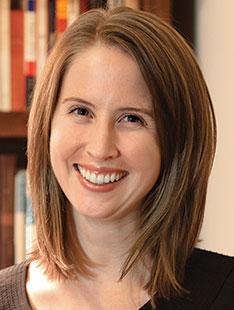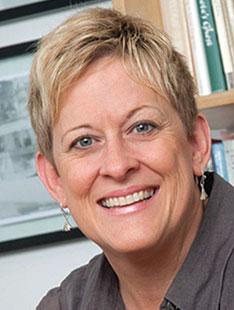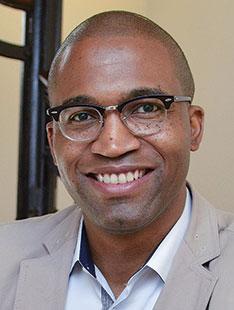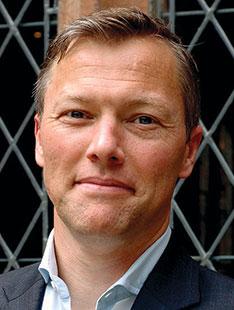Four prominent sociologists who recently joined Princeton’s faculty examine how to improve life at the margins of society — undertaking groundbreaking work on housing, education, welfare, and economics — and exposing the enduring consequences of poverty, racism, and lack of opportunity for so many in this country.
“These appointments highlight the significance of sociology as a discipline with a key role to play in contemporary society and the current university,” says Mitchell Duneier, chair of the sociology department. “They will help ensure that another generation of Princeton students is prepared to think critically and rigorously about society as they prepare for lives of civic engagement.”
JENNIFER JENNINGS ’00, professor of sociology and public affairs
As a graduate student at Columbia, Jennifer Jennings ’00 was frustrated that what she was learning about effective education reforms never made it into the public debates at a time when Mayor Michael Bloomberg was revamping the New York City school system. “We would have just had a class about how an education policy didn’t work, and then a district would roll it out as being highly effective,” she says.
So she started a blog, which was anonymous because blogging was seen as unserious in the academy, Jennings says. Eduwonkette published detailed analyses of education data, rebutting some of the mayor’s claims, and it soon had experts — and the media — abuzz.
Today, Jennings is trying to determine which reforms will help combat racial, socioeconomic, and gender disparities in educational outcomes. Her randomized study of 55,000 middle school students in New York City is offering informational materials and support to students who may choose where to apply to high school. It will assess whether providing simplified information about high-performing schools changes the school decisions families make.
While student teaching at a Trenton high school through Princeton’s Teacher Prep program, Jennings was stunned by the school’s lack of resources, particularly when she explored “the book closet” to look for teaching materials. “I found a book from 1901!” she recalls.
As a professor, she will be returning to Trenton, with Princeton students, to conduct new research. She has already reached out to many of the Trenton teenagers she once taught — and kept in touch with for more than a decade — who are now in their 20s and 30s, many with children in the same school system.
KATHRYN EDIN, professor of sociology and public affairs
Kathryn Edin has studied poverty in America for nearly three decades, but even she was astounded by what she discovered several years ago while interviewing poor mothers. During fieldwork in Baltimore to update her research on the lives of young people who had grown up in public housing, she met a woman named Ashley who had a 2-week-old baby and no formula to feed him. As she talked to other families, Edin found more of the same: They had no cash income from any source, including welfare.
After examining nationwide statistics, Edin discovered that the number of families living in extreme poverty had skyrocketed to 1.5 million American households, double what it had been in the mid-1990s. Those impoverished households are home to about 3 million children. Edin’s 2015 book on her findings, $2 a Day: Living on Almost Nothing in America, was hailed by noted Harvard sociologist William Julius Wilson as “essential.”
The situation is a byproduct of President Bill Clinton’s 1996 welfare reform, Edin and her co-author found, and the discretion it gave states on how to spend the lump-sum grants they received from the federal government. Most states have diverted the money, created stricter rules, or imposed more entry requirements. In 1970, 90 percent of those eligible for welfare were receiving it. Today, that number is roughly 30 percent, according to Edin. “When hard times came, it didn’t even occur to families to apply,” Edin says. “They told us, ‘Haven’t you heard? They don’t give that out anymore.’ ”
FREDERICK WHERRY *04, professor of sociology
Faced with an unexpected expense of $400, 44 percent of Americans reported that they would need to borrow money or sell something to make the payment, according to a recent study. Many would take out a short-term payday loan, which can have an effective interest rate as high as 400 percent, says Frederick Wherry *04: “Someone with no credit score has to go through a back door — and pay a lot more.”
In his research on how people handle credit and debt, Wherry has found that those seeking emergency loans often have steady jobs, but they are frequently made to feel ashamed at mainstream banks, which are reluctant to make small loans because the regulatory requirements are so onerous. When they visit a storefront payday lender, on the other hand, “they are often treated very well. And there is transparency — the prices are on the wall,” Wherry points out.
Wherry conducts research on how low-income workers cope with their finances at the Mission Asset Fund, a nonprofit organization in San Francisco, headed by José Quiñonez *98, which helps people build credit (see PAW’s cover story in the March 21, 2018, issue). Such workers — who often have fluctuating incomes — need better access to the financial system, says Wherry, because without that access, “the disadvantages accumulate and inequality grows.”
MATTHEW DESMOND, professor of sociology
Matthew Desmond spent more than a year living in low-income neighborhoods in Milwaukee in 2008 and 2009 to study an often overlooked problem plaguing the poor: evictions.
His subsequent book, Evicted: Poverty and Profit in the American City, won the 2017 Pulitzer Prize in general nonfiction. This spring, Desmond launched The Eviction Lab, which has created an online database that brings together 83 million eviction records gathered from all over the United States going back to 2000. It’s the first public archive of nationwide data on evictions.
“People wanted to know, what’s the eviction rate in our city? How many Americans get evicted each year? Nobody knew. We’ve been designing housing policy in the dark,” Desmond says. Now, scholars and public officials are able to better understand how evictions are related to race, crime rates, housing laws, and other factors.
Desmond found there were close to 900,000 eviction judgments in 2016, which represents one in 50 households that were renting. In Richmond, Va., the city with the second-highest rate of 2016 eviction judgments in the data, the median amount owed to a landlord was $686. Most poor renting families today spend more than half their income on housing.
Evictions take a huge toll on families — children can be forced to switch schools, and food stamps and Medicaid benefits can be lost because families don’t receive renewal notices sent to a former address.




